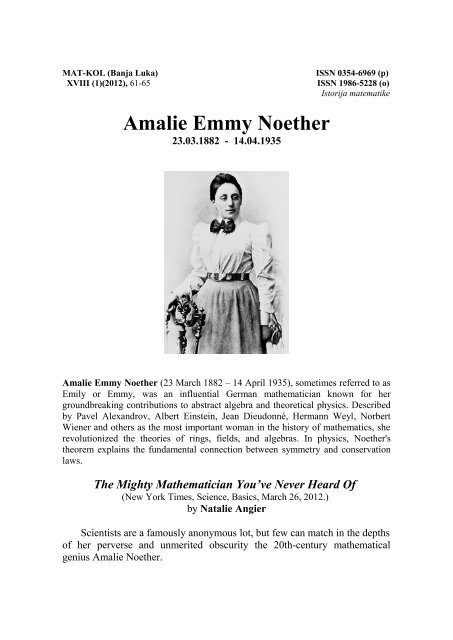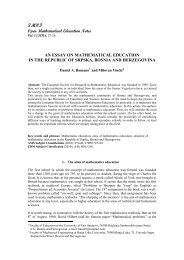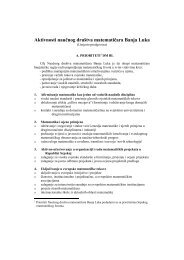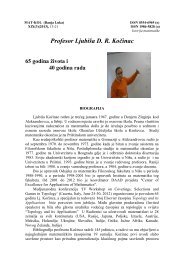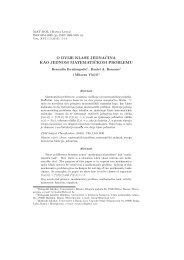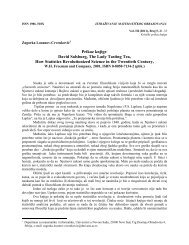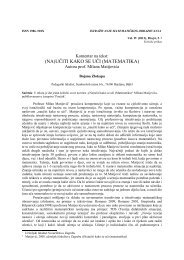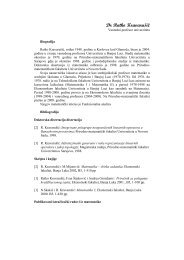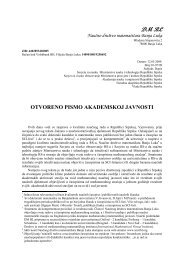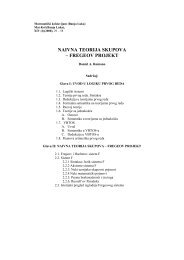Amalie Emmy Noether
Amalie Emmy Noether
Amalie Emmy Noether
Create successful ePaper yourself
Turn your PDF publications into a flip-book with our unique Google optimized e-Paper software.
MAT-KOL (Banja Luka) ISSN 0354-6969 (p)<br />
XVIII (1)(2012), 61-65 ISSN 1986-5228 (o)<br />
Istorija matematike<br />
<strong>Amalie</strong> <strong>Emmy</strong> <strong>Noether</strong><br />
23.03.1882 - 14.04.1935<br />
<strong>Amalie</strong> <strong>Emmy</strong> <strong>Noether</strong> (23 March 1882 – 14 April 1935), sometimes referred to as<br />
Emily or <strong>Emmy</strong>, was an influential German mathematician known for her<br />
groundbreaking contributions to abstract algebra and theoretical physics. Described<br />
by Pavel Alexandrov, Albert Einstein, Jean Dieudonné, Hermann Weyl, Norbert<br />
Wiener and others as the most important woman in the history of mathematics, she<br />
revolutionized the theories of rings, fields, and algebras. In physics, <strong>Noether</strong>'s<br />
theorem explains the fundamental connection between symmetry and conservation<br />
laws.<br />
The Mighty Mathematician You’ve Never Heard Of<br />
(New York Times, Science, Basics, March 26, 2012.)<br />
by Natalie Angier<br />
Scientists are a famously anonymous lot, but few can match in the depths<br />
of her perverse and unmerited obscurity the 20th-century mathematical<br />
genius <strong>Amalie</strong> <strong>Noether</strong>.
MAT-KOL, XVIII (1)(2012)<br />
Albert Einstein called her the most “significant” and “creative” female<br />
mathematician of all time, and others of her contemporaries were inclined to drop<br />
the modification by sex. She invented a theorem that united with magisterial<br />
concision two conceptual pillars of physics: symmetry in nature and the universal<br />
laws of conservation. Some consider <strong>Noether</strong>’s theorem, as it is now called, as<br />
important as Einstein’s theory of relativity; it undergirds much of today’s vanguard<br />
research in physics, including the hunt for the almighty Higgs boson. Yet <strong>Noether</strong><br />
herself remains utterly unknown, not only to the general public, but to many<br />
members of the scientific community as well.<br />
When Dave Goldberg, a physicist at Drexel University who has written about<br />
her work, recently took a little “<strong>Noether</strong> poll” of several dozen colleagues, students<br />
and online followers, he was taken aback by the results. “Surprisingly few could say<br />
exactly who she was or why she was important,” he said. “A few others knew her<br />
name but couldn’t recall what she’d done, and the majority had never heard of her.”<br />
<strong>Noether</strong> (pronounced NER-ter) was born in Erlangen, Germany, 130 years ago this<br />
month. So it’s a fine time to counter the chronic neglect and celebrate the life and<br />
work of a brilliant theorist whose unshakable number love and irrationally robust<br />
sense of humor helped her overcome severe handicaps — first, being female in<br />
Germany at a time when most German universities didn’t accept female students or<br />
hire female professors, and then being a Jewish pacifist in the midst of the Nazis’<br />
rise to power.<br />
Through it all, <strong>Noether</strong> was a highly prolific mathematician, publishing<br />
groundbreaking papers, sometimes under a man’s name, in rarefied fields of abstract<br />
algebra and ring theory. And when she applied her equations to the universe around<br />
her, she discovered some of its basic rules, like how time and energy are related, and<br />
why it is, as the physicist Lee Smolin of the Perimeter Institute put it, “that riding a<br />
bicycle is safe.”<br />
Ransom Stephens, a physicist and novelist who has lectured widely on <strong>Noether</strong>,<br />
said, “You can make a strong case that her theorem is the backbone on which all of<br />
modern physics is built.”<br />
<strong>Noether</strong> came from a mathematical family. Her father was a distinguished math<br />
professor at the universities of Heidelberg and Erlangen, and her brother Fritz won<br />
some renown as an applied mathematician. <strong>Emmy</strong>, as she was known throughout her<br />
life, started out studying English, French and piano — subjects more socially<br />
acceptable for a girl — but her interests soon turned to math. Barred from<br />
matriculating formally at the University of Erlangen, <strong>Emmy</strong> simply audited all the<br />
courses, and she ended up doing so well on her final exams that she was granted the<br />
equivalent of a bachelor’s degree.<br />
She went on to graduate school at the University of Göttingen before returning<br />
to the University of Erlangen, where she earned her doctorate summa cum laude.<br />
She met many of the leading mathematicians of the day, including David Hilbert and<br />
Felix Klein, who did for the bottle what August Ferdinand Möbius had done for the<br />
strip. <strong>Noether</strong>’s brilliance was obvious to all who worked with her, and her male<br />
mentors repeatedly took up her cause, seeking to find her a teaching position —<br />
better still, one that paid.<br />
62
MAT-KOL, XVIII (1)(2012)<br />
“I do not see that the sex of the candidate is an argument against her,” Hilbert<br />
said indignantly to the administration at Göttingen, where he sought to have <strong>Noether</strong><br />
appointed as the equivalent of an associate professor. “After all, we are a university,<br />
not a bathhouse.” Hilbert failed to make his case, so instead brought her on staff as a<br />
more or less permanent “guest lecturer”; and <strong>Noether</strong>, fittingly enough, later took up<br />
swimming at a men-only pool.<br />
At Göttingen, she pursued her passion for mathematical invariance, the study of<br />
numbers that can be manipulated in various ways and still remain constant. In the<br />
relationship between a star and its planet, for example, the shape and radius of the<br />
planetary orbit may change, but the gravitational attraction conjoining one to the<br />
other remains the same — and there’s your invariance.<br />
In 1915 Einstein published his general theory of relativity. The Göttingen math<br />
department fell “head over ear” with it, in the words of one observer, and <strong>Noether</strong><br />
began applying her invariance work to some of the complexities of the theory. That<br />
exercise eventually inspired her to formulate what is now called <strong>Noether</strong>’s theorem,<br />
an expression of the deep tie between the underlying geometry of the universe and<br />
the behavior of the mass and energy that call the universe home.<br />
What the revolutionary theorem says, in cartoon essence, is the following:<br />
Wherever you find some sort of symmetry in nature, some predictability or<br />
homogeneity of parts, you’ll find lurking in the background a corresponding<br />
conservation — of momentum, electric charge, energy or the like. If a bicycle wheel<br />
is radially symmetric, if you can spin it on its axis and it still looks the same in all<br />
directions, well, then, that symmetric translation must yield a corresponding<br />
conservation. By applying the principles and calculations embodied in <strong>Noether</strong>’s<br />
theorem, you’ll see that it is angular momentum, the Newtonian impulse that keeps<br />
bicyclists upright and on the move.<br />
Some of the relationships to pop out of the theorem are startling, the most<br />
profound one linking time and energy. <strong>Noether</strong>’s theorem shows that a symmetry of<br />
time — like the fact that whether you throw a ball in the air tomorrow or make the<br />
same toss next week will have no effect on the ball’s trajectory — is directly related<br />
to the conservation of energy, our old homily that energy can be neither created nor<br />
destroyed but merely changes form.<br />
The connections that <strong>Noether</strong> forged are “critical” to modern physics, said Lisa<br />
Randall, a professor of theoretical particle physics and cosmology at Harvard.<br />
“Energy, momentum and other quantities we take for granted gain meaning and<br />
even greater value when we understand how these quantities follow from symmetry<br />
in time and space.”<br />
Dr. Randall, the author of the newly published “Knocking on Heaven’s Door,”<br />
recalled the moment in college when she happened to learn that the author of<br />
<strong>Noether</strong>’s theorem was a she. “It was striking and even exciting and inspirational,”<br />
Dr. Randall said, admitting, “I was surprised by my reaction.”<br />
For her part, <strong>Noether</strong> left little record of how she felt about the difficulties she<br />
faced as a woman, or of her personal and emotional life generally. She never<br />
married, and if she had love affairs she didn’t trumpet them. After meeting the<br />
young Czech math star Olga Taussky in 1930, <strong>Noether</strong> told friends how happy she<br />
63
MAT-KOL, XVIII (1)(2012)<br />
was that women were finally gaining acceptance in the field, but she herself had so<br />
few female students that her many devoted pupils were known around town as<br />
<strong>Noether</strong>’s boys.<br />
<strong>Noether</strong> lived for math and cared nothing for housework or possessions, and if<br />
her long, unruly hair began falling from its pins as she talked excitedly about math,<br />
she let it fall. She laughed often and in photos is always smiling.<br />
When a couple of students started showing up to class wearing Hitler’s<br />
brownshirts, she laughed at that, too. But not for long. <strong>Noether</strong> was one of the first<br />
Jewish scientists to be fired from her post and forced to flee Germany. In 1933, with<br />
the help of Einstein, she was given a job at Bryn Mawr College, where she said she<br />
felt deeply appreciated as she never had been in Germany.<br />
That didn’t last long, either. Only 18 months after her arrival in the United<br />
States, at the age of 53, <strong>Noether</strong> was operated on for an ovarian cyst, and died within<br />
days.<br />
References for <strong>Emmy</strong> <strong>Noether</strong><br />
1. A Kramer, Biography in Dictionary of Scientific Biography (New York 1970-1990).<br />
http://www.encyclopedia.com/doc/1G2-2830903187.html<br />
2. Biography in Encyclopaedia Britannica.<br />
http://www.britannica.com/eb/article-9056031/<strong>Emmy</strong>-<strong>Noether</strong><br />
Books:<br />
3. A Dick, <strong>Emmy</strong> <strong>Noether</strong>, Revue de mathématique élémentaires 13 (Basel, 1970).<br />
4. A Dick, <strong>Emmy</strong> <strong>Noether</strong>, 1882-1935 (Boston, 1981).<br />
5. A Dick, <strong>Emmy</strong> <strong>Noether</strong>: 1882-1935, Elem. Math. Beiheft 13 (Basel, 1970).<br />
6. C Kimberling, <strong>Emmy</strong> <strong>Noether</strong> and her influence, in J W Brewer and M K Smith (eds.),<br />
<strong>Emmy</strong> <strong>Noether</strong> : A tribute to her life and work (New York, 1981).<br />
7. B Srinivasan and J Sally, <strong>Emmy</strong> <strong>Noether</strong> in Bryn Mawr (New York-Berlin, 1983).<br />
8. H Wussing, E <strong>Noether</strong>, in H Wussing and W Arnold, Biographien bedeutender<br />
Mathematiker (Berlin, 1983).<br />
Articles:<br />
9. N Byers, The Life and Times of <strong>Emmy</strong> <strong>Noether</strong>; contributions of E <strong>Noether</strong> to particle<br />
physics, in H B Newman and T Ypsilantis (eds) History of Original Ideas and Basic<br />
Discoveries in Particle Physics (New York 1996).<br />
10. N Byers, E <strong>Noether</strong>'s Discovery of the Deep Connection Between Symmetries and<br />
Conservation Laws, Israel Mathematical Conference Proceedings 12 (1999).<br />
11. P S Chee, <strong>Emmy</strong> <strong>Noether</strong>-an energetic washerwoman, Bull. Malaysian Math. Soc. 6<br />
(3) (1975), 1-9.<br />
12. K N Cheng, <strong>Emmy</strong> <strong>Noether</strong> (1882-1935), Math. Medley 7 (1) (1979), 13-17.<br />
13. J Dieudonné, <strong>Emmy</strong> <strong>Noether</strong> and algebraic topology, J. Pure Appl. Algebra 31 (1-3)<br />
(1984), 5-6.<br />
14. P Dubreil, <strong>Emmy</strong> <strong>Noether</strong>, Proceedings of the seminar on the history of mathematics 7<br />
(Paris, 1986), 15-27.<br />
64
MAT-KOL, XVIII (1)(2012)<br />
15. K-H Schlote, <strong>Emmy</strong> <strong>Noether</strong>-zum 100: Geburtstag, Mitt. Math. Ges. DDR 1 (1983), 49-<br />
60.<br />
16. H A Kastrup, The contributions of <strong>Emmy</strong> <strong>Noether</strong>, Felix Klein and Sophus Lie to the<br />
modern concept of symmetries in physical systems, Symmetries in physics (1600-1980)<br />
(Barcelona, 1987), 113-163.<br />
17. C Kimberling, <strong>Emmy</strong> <strong>Noether</strong>, Amer. Math. Monthly 79 (1972), 136-149.<br />
18. I Kleiner, <strong>Emmy</strong> <strong>Noether</strong> : Highlights of her life and work, L'Ensignement<br />
Mathématique 38 (1992), 103-124.<br />
19. C Lanczos, <strong>Emmy</strong> <strong>Noether</strong> and the calculus of variations, Bull. Inst. Math. Appl. 9 (8)<br />
(1973), 253-258.<br />
20. G E <strong>Noether</strong>, <strong>Emmy</strong> <strong>Noether</strong> (1882-1935), in L S Grinstein and P J Campbell (eds.),<br />
Women of Mathematics (Westport, Conn., 1987), 165-170.<br />
21. E P <strong>Noether</strong> and G E <strong>Noether</strong>, <strong>Emmy</strong> <strong>Noether</strong> in Erlangen and Göttingen, <strong>Emmy</strong><br />
<strong>Noether</strong> in Bryn Mawr (New York-Berlin, 1983), 133-137.<br />
22. G S Quinn, R S McKee, M Lehr and O Taussky, <strong>Emmy</strong> <strong>Noether</strong> in Bryn Mawr, <strong>Emmy</strong><br />
<strong>Noether</strong> in Bryn Mawr (New York-Berlin, 1983), 139-146.<br />
23. S-B Ng, <strong>Emmy</strong> <strong>Noether</strong>-a great woman mathematician of modern times, Menemui<br />
Mat. 8 (1) (1986), 1-8.<br />
24. C Tollmien, Die Habilitation von <strong>Emmy</strong> <strong>Noether</strong> an der Universität Göttingen, NTM<br />
Schr. Geschichte Natur. Tech. Medizin 28 (1) (1991), 13-32.<br />
25. Uta C Merzbach, <strong>Emmy</strong> <strong>Noether</strong>: historical contexts, <strong>Emmy</strong> <strong>Noether</strong> in Bryn Mawr<br />
(New York-Berlin, 1983), 161-171.<br />
26. B L van der Waerden, Nachruf auf <strong>Emmy</strong> <strong>Noether</strong>, Mathematische Annalen 111<br />
(1935), 469-476.<br />
27. B L van der Waerden, The school of Hilbert and <strong>Emmy</strong> <strong>Noether</strong>, Bull. London Math.<br />
Soc. 15 (1) (1983), 1-7.<br />
28. H Weyl, <strong>Emmy</strong> <strong>Noether</strong>, Scripta mathematica 3 (1935), 201-220.<br />
65


